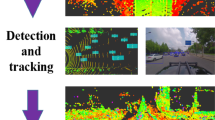Abstract
Semantic mapping of static environments has become a hot topic in robotics. The aim of the Mermaid project was to investigate the transfer of a sensor data interpretation approach for mapping to the problem of activity recognition in smart home applications such as elderly care. The basic structure of the semantic mapping approach, i.e., to assemble hypotheses of object aggregates in a closed-loop process of bottom-up raw data interpretation and top-down expectation generation from a domain ontology, can be extended to the temporal domain to include activity interpretation. This paper reports initial results, based on a study using point clouds from depth (RGB-D) sensor data.



Similar content being viewed by others
Explore related subjects
Discover the latest articles, news and stories from top researchers in related subjects.References
Albrecht S, Wiemann T, Günther M, Hertzberg J (2011) Matching CAD object models in semantic mapping. In: Proc ICRA 2011 workshop on semantic perception, mapping and exploration
Allen JF (1983) Maintaining knowledge about temporal intervals. Commun ACM 26(11):832–843
Bhatt M, Loke S (2008) Modelling dynamic spatial systems in the situation calculus. Spat Cogn Comput 8(1):86–130
Bohlken W, Koopmann P, Neumann B (2011) Scenior: ontology-based interpretation of aircraft service activities. Tech rep FBI-HH-B-297/11, Department of Informatics, University of Hamburg
Chen L, Nugent C, Biswas J, Hoey J (eds) (2011) Activity recognition in pervasive intelligent environments. Atlantis Press, Amsterdam
Chua SL, Marsland S, Guesgen HW (2009) Behaviour recognition from sensory streams in smart environments. In: Proc AUS-AI
Chua SL, Marsland S, Guesgen HW (2009) Spatio-temporal and context reasoning in smart homes. In: Proc COSIT workshop on spatial and temporal reasoning for ambient intelligence systems. 2009
Coradeschi S, Saffiotti A (2003) An introduction to the anchoring problem. J Robot Auton Syst 43(2–3):85–96
Galton AP (1993) Towards an integrated logic of space, time and motion. In: Proc IJCAI-93, pp 1550–1555
Gao J, Hauptmann AG, Bharucha A, Wactlar HD (2004) Dining activity analysis using a hidden Markov model. In: Proc ICPR2004, pp 915–918
Guesgen H, Marsland S (2011) Recognising human behaviour in a spatio-temporal context. In: Chong NY, Mastrogiovanni F (eds) Handbook of research on ambient intelligence and smart environments: trends and perspective. IGI Global, Hershey, pp 443–459
Guesgen HW, Marsland S (2010) Recognising human behaviour in a spatio-temporal context. IGI Global, Hershey
Günther M, Wiemann T, Albrecht S, Hertzberg J (2011) Model-based object recognition from 3d laser data. In: Proc KI-2011, pp 99–110
Harnad S (1990) The symbol grounding problem. Physica D 42:335–346
Hertzberg J, Lingemann K, Nüchter A (2012) Mobile Roboter. Eine Einführung aus Sicht der Informatik. Springer-Vieweg, Berlin
Hoppe H, DeRose T, Duchamp T, McDonald J, Stuetzle W (1992) Surface reconstruction from unorganized points. Comput Graph 26(2)
Kim D, Song J, Kim D (2007) Simultaneous gesture segmentation and recognition based on forward spotting accumulative HMMs. Pattern Recognit 40(11):3012–3026
Kortenkamp D, Simmons R (2008) Robotic systems architectures and programming. In: Siciliano B, Khatib O (eds) Springer Handbook of Robotics. Springer, Berlin, pp 187–206, Chap 8
Lorensen WE, Cline HE (1987) Marching cubes: a high resolution 3D surface construction algorithm. In: ACM SIGGRAPH
Lyons P, Cong AT, Steinhauer HJ, Marsland S, Dietrich J, Guesgen HW (2010) Exploring the responsibilities of single-inhabitant smart homes with use cases. J Ambient Intell Smart Environ 2(3):211–232
Neumann B, Möller R (2008) On scene interpretation with description logics. Image Vis Comput 26(1):82–101
Nilsson N (1984) Shakey the robot. Tech rep TN 323, SRI International
Nüchter A, Hertzberg J (2008) Towards semantic maps for mobile robots. J Robot Auton Syst 56(11):915–926
Schnabel R, Wahl R, Klein R (2007) Efficient ransac for point-cloud shape detection. Comput Graph Forum 26(2):214–226
Tapia EM, Intille SS, Larson K (2004) Activity recognition in the home using simple and ubiquitous sensors. In: Proc PERVASIVE, pp 158–175
Wiemann T, Lingemann K, Nüchter A, Hertzberg J (2012) A toolkit for automatic generation of polygonal maps—Las Vegas reconstruction. In: Proc ROBOTIK-12, pp 446–451
Wu JK, Dong L, Xiao W (2007) Real-time physical activity classification and tracking using wearable sensors. In: Proc ICICSP 2007, pp 1–6
Zappi P, Stiefmeier T, Farella E, Roggen D, Benini L, Tröster G (2007) Activity recognition from on-body sensors by classifier fusion: sensor scalability and robustness. In: Proc ISSNIP’07, pp 281–286
Acknowledgements
Work in the project Mermaid reported here was partially funded by BMBF (grant NZL 10/003) and the RSNZ (grant FRG10-11) under a bilateral research collaboration agreement. This is gratefully acknowledged.
Author information
Authors and Affiliations
Corresponding author
Rights and permissions
About this article
Cite this article
Albrecht, S., Wiemann, T., Hertzberg, J. et al. From Object Recognition to Activity Interpretation and Back, Based on Point Cloud Data. Künstl Intell 27, 161–167 (2013). https://doi.org/10.1007/s13218-013-0244-5
Published:
Issue Date:
DOI: https://doi.org/10.1007/s13218-013-0244-5




